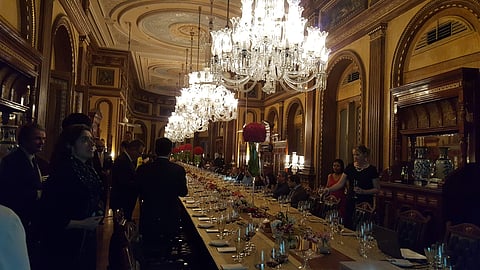
- LIFESTYLE
- FASHION
- FOOD
- ENTERTAINMENT
- EVENTS
- CULTURE
- VIDEOS
- WEB STORIES
- GALLERIES
- GADGETS
- CAR & BIKE
- SOCIETY
- TRAVEL
- NORTH EAST
- INDULGE CONNECT

The quietly regal Falaknuma Palace, now managed by the Taj group of hotels, is getting to be acknowledged in global hospitality circles, as the proverbial jewel in the crown of Hyderabad, especially in the context of its inherently opulent Nizami legacy. The first sighting, from the road below, of the marble-hued palace perched on a hillock, invariably always pulls at your heartstrings for its sheer beauty, vastness and royal remoteness. And if you are lucky to get the rare horse carriage (as opposed to the more modern buggy) to transport you up the long driveway right to the steps of the palace, you can’t help feeling royal, even if it be for a day! It seemed appropriate, therefore, that Bordeaux, the port city of France, which produces the world’s best wine, should decide to host its debut wine tasting session in Hyderabad at the Taj Falaknuma Palace. The guests consisting of the Telangana government officials, star hotel GMs and restaurateurs, besides wine connoisseurs (sommelier Magandeep Singh and the Chigurupati couple who have their own Krsma brand of premium wines), were treated to some Grands Crus classes wines, seated at Falaknuma’s famed 101 dining table, known to have hosted royalty in the days of yore, including King Edward VIII of Britain and the last Czar of Russia. The French were impressed by the plushness of the dining space. As the co-host for the evening, Ambassador of France to India Alexandre Ziegler, who also happen to be from Bordeaux remarked in jest, says, “This is just so fabulous but I am checking out tomorrow morning, because I can’t afford to stay here for longer.”
Bordeaux’s historical parts fall under UNESCO World heritage list, and wine has been produced here since the eighth century. The year 1855 marked a milestone year of classification of premium wines known as Grand Crus classes, based on the reputation of the wines and their transaction prices. This was ordered by Napolean III to be ready for the Exposition Universelle, an international trade expo. While Bordeaux’s Chateaus, some with spectacular architecture, dating from hundreds of years vintage with beautifully manicured lawns, had been off limits, some of them have now been thrown open to tourists by the proprietors. We sampled four red wines from three chateaus that day, two from Chateau Margaux, called Desmirail and Lascombes, one from Chateau St Julien (Langua Barton) and Pauillac (Batailley), and were explained by the chateau proprietors and representatives, about their characteristics, flavours and ‘tannins’ content, which add bitterness, astringency and complexity.
There were two white wines, more on the lines of dessert wines with their intensely sweet flavour - these were from Chateau Barsac (Nairac) and Chateau Sauternes (Rieussec). I will confess that I am not a red wine person, so the tannins of the Grands Crus red wines did not impress my palate. However, both the white wines had a sparkling tingle on the palate, though they were overly sweet. I was amused to hear that one of them was made of rotten grade grapes! According to the president of international relations at Bordeaux Metropole Michel Vernejoul, an estimated number of six million tourists visit the wine city, and the newly launched wine museum makes it an attractive wine tourism destination. Bordeaux topped the Lonely Planet’s list of the world’s ten best places to visit in 2017. I have added it to my bucket list, God willing!
(The writer is a journalist, blogger, food critic and a self-professed culture vulture)